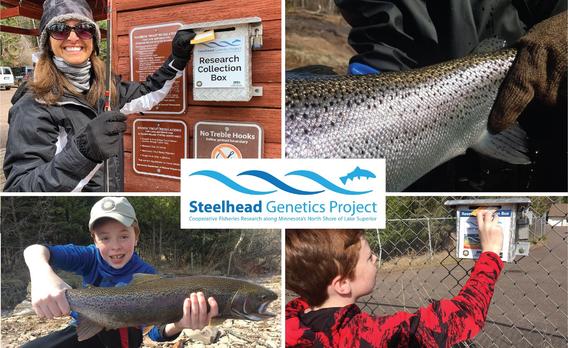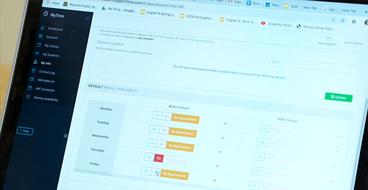In 2019, Government Innovation in Minnesota recognized innovative programs and services from around the state. But the challenges being faced as a result of the COVID-19 pandemic have forced many to change course. We followed up with two of last year’s awardees to hear how their innovations have confronted the obstacles of this year.
Minnesota Department of Natural Resources: Fisheries’ Steelhead Genetics Project
The DNR’s Steelhead Genetics Project was a cooperative fishery research program that utilized volunteer anglers to collect genetic samples from steelhead in Minnesota waters of Lake Superior. “We built a really good community of anglers and stakeholders,” said Cory Goldsworthy, Lake Superior Area Fisheries supervisor with the DNR. This community of anglers has allowed them to continue their vital research efforts on coaster brook trout, and perhaps has provided a bellwether for how we may rethink conservation and restoration.
While the DNR certainly has its own teams of researchers, it requires two teams of three people to utilize the electrofishing gear—think Ghostbusters—which proves to be a significant barrier with the added need to protect staff and maintain proper social distance, not to mention the need for, and cost of, safe travel and lodging.
By utilizing the community of anglers and moving permits, training, and data collection to digital formats, the office has been able to continue the work of their decade-long fisheries management plan.
This years-long timetable appears at the forefront of the work. Since 1996, conservation and state leaders have developed and revised a 10-year fisheries management plan.
As Goldsworthy notes, “There’s a conservation ethic. Think in decades” rather than years or seasons, as many do when it comes to fishing. And the use of anglers in data collection has provided a seat at the table to those not traditionally involved in the research and work necessary to fulfill these management plans. “It gives them stake in the game,” said Goldsworthy about this angler community.
The work the DNR needs to do to conserve and maintain fisheries is sourced, in part, from pine forest logging over 100 years ago, other landscape changes that have affected waterways, and, undoubtedly, climate change. Goldsworthy noted this work is trying to maintain waters from a cold, deep, glacial lake, where species are long-lived. So, it makes good sense to think in such long time periods. By leaning on anglers and passing down this mindset, perhaps more Minnesotans will begin to think the same way.
Minnesota Department of Natural Resources
For more information, visit minnesotasteelheader.com
Wayzata High School: The Hub
At Wayzata High School, innovation and change may very well be a part of the culture. In 2016, Wayzata's school district created the Hub, an online platform that allows teachers to engage with students and provide meaningful intervention opportunities. While it gave the school a digital foothold prior to the pandemic’s forced closure of schools around the state, it was not impervious to the challenges so many school districts have faced.
Vice Principal Tyler Shepard said changes to the program were always a goal, and the programming effort called for constant tweaks and adjustments. But the onset of COVID-19? “It accelerated our need to do it in a more efficient way,” he said. As schools across the state closed their doors and moved to online formats in the spring of 2020, many dealt with uncertainty. Despite the innovations and programs created prior to the shutdown, the issue of uncertainty did not skip past Wayzata’s school district—but it did present an opportunity.
The Hub, which has altered its original intervention format to serve as a more digital-friendly communication tool, is working to better serve students and provide more meaningful communication between teachers, students, and family.
“Over the summer, we made promises to our students and parents, and one of them was this intervention day,” said Shepard. Now, instead of teachers asking for short blocks of time to meet with students during specified hours of in-building education, teachers have dedicated Fridays to this time and communicate using the tool more regularly.
But the existence of the Hub allowed for even more advanced support: Mindfulness sessions designed to break up the academic rigor and monotony of online schooling and better-at-home orders. Student support teams designed to track intervention and allow for teachers to help each other reach individual students better.
This innovation, and the school’s commitment to improvement, has succeeded in part from the school’s culture of trust that has anticipated and allowed for these changes. The Hub is far from complete; it’s clearly undergoing changes and improvements, which very much seems to be the objective of Wayzata High School.
Speaking of how these improvements will hold up when in-person classes can eventually return in earnest, Shepard noted, “We’re keeping it all. It’s a lot better than the old-school way of teachers communicating with students. Names on blackboards are out.”
"In the beginning, we were hopeful that we could develop a system to provide students and teachers with a scheduling tool for interventions, which would help with management during this time and also strengthen communication between students, teachers, and parents/guardians," Shepard said. "This has since evolved into much more in terms of more tools, all with a consistent focus—strengthening communication, providing support, increasing efficiencies, and collaborating on student interventions."
These tools include teacher availability, journaling, teacher notes, distance learning support, support team "boards," college visits, digital hall passes, and personalized learning plans.
With 3,700 students supported, a small network of schools independently utilizing the Hub to operationalize communication management and sharing best-practice strategies, and a dedicated district open to feedback, the Hub’s original goal is a fair bit different than what Wayzata High School has now.
Video on Wayzata High School’s Hub from LGIA, 2019
Wayzata Public Schools
The Hub was designed and programmed by Sheri Berggren, Level8 Creative.



